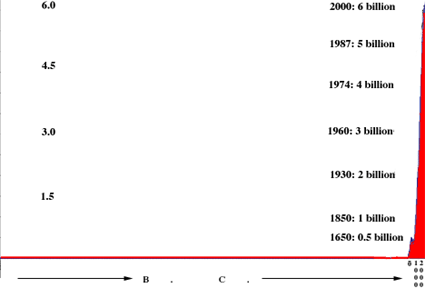TROPICAL RAINFORESTS: Imperiled Riches—Threatened Rainforests
Human Population Growth
|
|
The graph above shows human population growth over the past 25,000 years or so. As evident, the graph is fairly boring—there is a virtually constant human population, up until around 1 A.D., when growth rates accelerate. The small downward spike during the mid-2nd millennium A.D. reflects the impact of the black plague. By the mid-19th century population growth reaches exponential proportions, a trend that continues today.
Though human population is still increasing at a substantial rate, the birth rate worldwide has peaked and now looks to be declining. This means that each woman is having fewer children. However, the problem remains that least-developed countries still have a huge population that is yet to reproduce (under the age of 15). In the coming years, as these women begin to reproduce, the population will continue to expand.
What is the best way to slow population growth? Many will argue, citing numerous studies, that women's education has the most significant effect in curbing the number of children they have. Encouraging later marriages, say marrying at 21 instead of 16, can also materially reduce the number of children brought into the world each year, as can improved access to contraceptives.
Population Growth Profile, 1998.
| Region |
New growth (millions) |
New growth (%) |
| Sub-Saharan Africa |
15.7 |
20.0 |
| Nigeria |
3.3 |
� |
| Congo (Kinshasa) |
1.4 |
� |
| Ethiopia |
1.3 |
� |
| Near East and North Africa |
7.1 |
9.0 |
| Egypt |
1.2 |
� |
| Turkey |
1.0 |
� |
| Asia and Oceania |
44.7 |
56.8 |
| India |
16.5 |
� |
| China |
10.6 |
� |
| Indonesia |
3.2 |
� |
| Latin America and the Caribbean |
7.8 |
44.7 |
| Brazil |
2.1 |
� |
| Mexico |
1.7 |
� |
| More Developed Countries |
2.9 |
3.7 |
| United States |
2.3 |
� |
| Total |
78.2 |
100.0 |
source: U.S. Bureau of the Census 1999
2003 article on declining fertility rates
Current World Population Statistics
World's Largest Cities
Continued: Economic Restructuring
